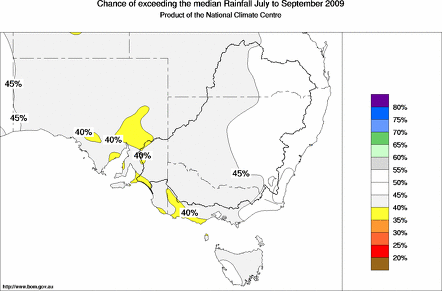| Southeastern Aust Seasonal Rainfall Outlook: probabilities for July to September 2009, issued 23rd June 2009 | |||||||||
A drier season favoured in parts of SA and VictoriaFor southeastern Australia, the outlook for total rainfall over the September quarter (July to September) indicates that in relatively small parts of SA and Victoria, there are moderate shifts in the odds favouring a drier than normal season. On the whole though, the chances of above normal falls are about the same as the chances of below normal. The pattern of seasonal rainfall odds across southeast Australia is a result of recent warm conditions in the Indian Ocean and an increasing level of warmth in the Pacific. The influences from these two oceans counteract each other in northern NSW: the Indian Ocean pattern promotes wetter conditions while the Pacific biases the climate towards a drier than normal season. Further south, the two patterns tend to reinforce each other. 
For the July to September period, the chance of exceeding median rainfall is between 40 and 50% over most of the southeastern region (see map). The chances drop to the 35 and 40% range in a few areas in central and southeast South Australia and the far southwest of Victoria, indicating an increased risk of dry conditions. For these small regions this means that for every ten years with ocean patterns like the current, about four years would be expected to be wetter than average during the September quarter, with about six being drier. New: An expanded set of seasonal rainfall outlook maps and tables, including the probabilities of seasonal rainfall exceeding given totals (e.g. 200 mm), is available on the "Water and the Land" (WATL) part of the Bureau's website. Outlook confidence is related to how consistently the Pacific and Indian Oceans affect Australian rainfall. During July to September, history shows that the effect is only weakly to very weakly consistent in areas of southeastern and far western SA, Victoria, western NSW and most of Tasmania (see background information). The effect is moderately consistent across the remainder of NSW and SA. The area of very weak consistency in southeast NSW stretches across the border to include the southeastern part of Victoria. In these areas where outlook confidence is not high, caution should be used when interpreting these outlooks. Changes in the climate patterns across the Pacific and the latest outputs from computer models point to an emerging El Niño event. A media release regarding this was issued on 3rd June. The SOI is approximately −10 for the 30 days ending 20 June. For routine updates and comprehensive discussion on any developments please see the ENSO Wrap-Up. | |||||||||
Click on the map above for a larger version of the map. Use the reload/refresh button to ensure the latest forecast map is displayed. More detailed forecast maps, including the probabilities of seasonal rainfall exceeding given totals, can be found here. | |||||||||
|
More information on this outlook is available Monday to Friday from 9.00am to 5.00pm local time by contacting the Bureau's Climate Services sections in Queensland, NSW, SA, Victoria and Tasmania at the following numbers:
| |||||||||
THE NEXT ISSUE OF THE SEASONAL OUTLOOK IS EXPECTED BY 24th July 2009 Corresponding temperature outlook | |||||||||
Background Information
| |||||||||









